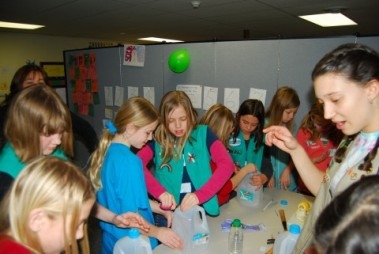 Since 2007, the Girl Scouts Council Nation’s Capital Chapter has organized a Girl Scout Science Day to give local Girl Scouts an opportunity to learn more about science in a fun and friendly environment. The goal from day one has been to introduce scientific terms and concepts, but in a way that demonstrates the role of science in day-to-day life. All participating Girl Scouts also earn a badge in a scientific topic related to the experiments they perform.
Since 2007, the Girl Scouts Council Nation’s Capital Chapter has organized a Girl Scout Science Day to give local Girl Scouts an opportunity to learn more about science in a fun and friendly environment. The goal from day one has been to introduce scientific terms and concepts, but in a way that demonstrates the role of science in day-to-day life. All participating Girl Scouts also earn a badge in a scientific topic related to the experiments they perform.
I first became involved as my friend is the troop leader in charge of the event. She and I would work on ideas, adapt experimental protocols, and talk our science friends into volunteering at the event. I always get the easier job—she also would order supplies, arrange registration for all the troops, schedule volunteers, and put together all of the lab manuals for each Girl Scout that contains the experiments they would be performing during the day. Hands-on experimental protocols are designed to be performed by a group of 10–12 girls in 30 minutes. From the beginning, experiments have been led by Cadette or Senior Girl Scouts with the assistance of volunteers, including troop "moms" and "dads" and area scientists.
All participating Girl Scouts rotate through four to five experiments depending on their age group and the theme their troop has selected. Experiments are designed to be age-appropriate for Girl Scouts in Grades 2–3 and 4–6. In 2009, an additional session was added to allow the Teen Girl Scouts to learn some more complex science issues and to meet some area scientists to discuss careers in science.
What started as two sessions on a Saturday in early January has now become six sessions over two weekends in November, due in large part to the efforts of the Girl Scout leader in charge and the support of the National Capital Area Chapter of the Society of Toxicology. The event has gone from reaching out to ~200 Girl Scouts a year to over 400. Through the years, we have partnered with local businesses (MDBio, ToxServices) and academic institutions (Towson University). We have hands-on experiments that address concepts of chemistry, microbiology, genetics, and toxicology. We have had discussions related to what goes into your personal hygiene products, why DNA is unique to each of us, and how forensic science can help to solve a crime.
 At this point the Cadette and Senior Girl Scouts running the experiments are the same 4th graders that were having them explained to them 5 years ago. Looking back through the years, it has been a pleasure to see these girls not only learn the scientific concepts well enough to teach them to the new Brownie and Junior Girl Scouts, but to watch them take on more and more responsibility for the event itself. The Cadettes assist in the set-up and breakdown of the experiments, and are responsible for cleaning up the local church where the event is held, free of charge. Through my involvement in this event, I have been privileged to watch those young giggly 10-year-old girls turn into responsible young ladies—that still giggle, but do so while teaching or setting up for the next group of girls. This event also led to my volunteer work in education outreach, including outreach activities modeled after the Girl Scout Science Day, such as those associated with the Society of Toxicology Annual Meeting and as part of the USA Science & Engineering Festival.
At this point the Cadette and Senior Girl Scouts running the experiments are the same 4th graders that were having them explained to them 5 years ago. Looking back through the years, it has been a pleasure to see these girls not only learn the scientific concepts well enough to teach them to the new Brownie and Junior Girl Scouts, but to watch them take on more and more responsibility for the event itself. The Cadettes assist in the set-up and breakdown of the experiments, and are responsible for cleaning up the local church where the event is held, free of charge. Through my involvement in this event, I have been privileged to watch those young giggly 10-year-old girls turn into responsible young ladies—that still giggle, but do so while teaching or setting up for the next group of girls. This event also led to my volunteer work in education outreach, including outreach activities modeled after the Girl Scout Science Day, such as those associated with the Society of Toxicology Annual Meeting and as part of the USA Science & Engineering Festival.
In 2006, doing education outreach was not something I even thought about. But after participating in the Girl Scout Science Day for the past five years, I enjoy every opportunity I have to encourage kids to have fun with science, to ask questions about how things work, and to work together to solve scientific problems. The Society of Toxicology Education Committee has ways to help support these types of opportunities, and for K–12 in particular we are putting together a website of ideas, experiments, and how-to’s to get you started in the new year. Please don’t hesitate to contact the Education Subcommittee: K–12 with any questions or advice. The impact these events have on the kids involved is worth the effort.
Experimental protocols available upon request.